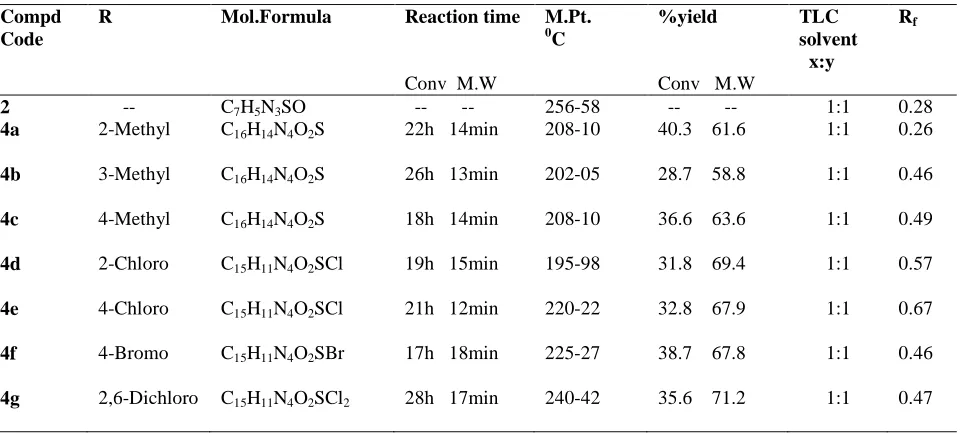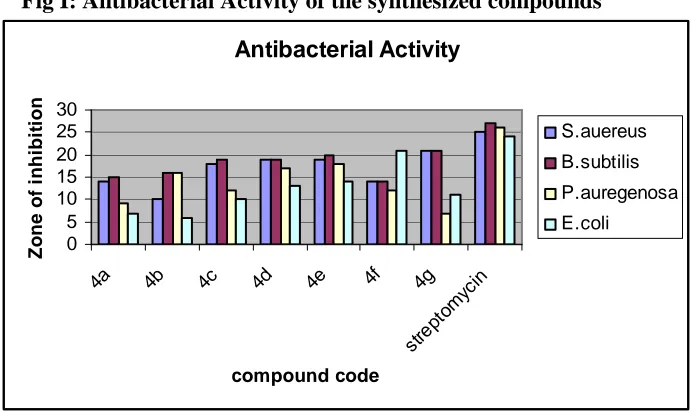Journal of Chemical and Pharmaceutical Research
__________________________________________________
ISSN No: 0975-7384
J. Chem. Pharm. Res., 2010, 2(2): 101-106
101
Microwave assisted synthesis of some 5-pyridyl-2-[(N-substituted
phenyl) thioacetamido]-1,3,4-oxadiazoles as antibacterial and
antioxidant agents
S. Rajasekaran*1, Gopal Krishna Rao1, Sanjay Pai. P. N2 and Vedavathy. J1
1
Department of Pharmaceutical Chemistry, Al-Ameen College of Pharmacy, Bangalore
2
Department of Quality Assurance, Al-Ameen College of Pharmacy, Bangalore
______________________________________________________________________________
Abstract
A series of some 5-pyridyll-2-[(N-substituted phenyl) thioacetamido]-1,3,4-oxadiazoles were synthesized by both conventional and microwave method and characterized on the basis of IR, NMR Mass Spectral and elemental analysis. The title compounds were subjected for antibacterial activity against both gram positive and gram negative organisms and invitro antioxidant activity by 1,1-diphenyl-2,2-picryl hydrazyl free radical (DPPH) method.
Key words: 1,3,4-oxadiazole; antibacterial; invitro antioxidant activity (DPPH).
______________________________________________________________________________
Introduction
102
destruction. Free radicals are also involved in the biosynthesis of prostaglandins, important mediators of inflammation. Compounds with antioxidant properties are generally expected to protect against inflammation. Several substituted chloroacetamide derivatives are reported to possess anti-inflammatory and/or antioxidant activities.
Hence in our investigation it was aimed to synthesize substituted oxadiazole derivatives and screen for their antibacterial and antioxidant activity.
Materials and methods
Experimental
[image:2.595.70.550.453.670.2]Melting points were measured in open capillary tubes and are uncorrected IR (KBR) spectra were recorded in film or in potassium bromide disks on a Perkin-Elmer 398 spectrophotometer (υ max in cm-1) and 1H NMR spectra on a DPX 300 MHz Bruker FT-NMR spectrophotometer. The chemical shifts were reported as parts per million (δ ppm) tetramethyl silane (TMS ) as internal standard. Mass spectra were obtained on a JEOL-SX-102 instrument using fast atom bombardment (FAB positive). Elemental analysis was performed on a Perkin–Elmer 2400 C,H,N analyzer. The progress of the reaction was monitored on a ready made silicagel plates (Merck) using n-hexane: ethyl acetate as a solvent system. Spectral data (IR, NMR and Mass spectra) confirmed the structure of the synthesized compounds and the purity of these compounds were ascertained by microanalysis. Elemental (C,H,N) analysis indicated that the calculated and observed values were within the acceptable limits (±0.4%). Physical data for the compounds are given in Table 1 and analytical data are given in Table II. Synthetic route is depicted in Scheme 1.
Table 1: Physical Data of the synthesized compounds
Compd Code
R Mol.Formula Reaction time M.Pt.
0
C
%yield TLC solvent x:y
Rf
Conv M.W Conv M.W
2 -- C7H5N3SO -- -- 256-58 -- -- 1:1 0.28
4a 2-Methyl C16H14N4O2S 22h 14min 208-10 40.3 61.6 1:1 0.26
4b 3-Methyl C16H14N4O2S 26h 13min 202-05 28.7 58.8 1:1 0.46
4c 4-Methyl C16H14N4O2S 18h 14min 208-10 36.6 63.6 1:1 0.49
4d 2-Chloro C15H11N4O2SCl 19h 15min 195-98 31.8 69.4 1:1 0.57
4e 4-Chloro C15H11N4O2SCl 21h 12min 220-22 32.8 67.9 1:1 0.67
4f 4-Bromo C15H11N4O2SBr 17h 18min 225-27 38.7 67.8 1:1 0.46
4g 2,6-Dichloro C15H11N4O2SCl2 28h 17min 240-42 35.6 71.2 1:1 0.47
_____________________________________________________________________________
[image:3.595.76.515.109.397.2]103
Table II: IR and 1H NMR data of the newly synthesized compounds
Compd. Code
IR νmax (cm-1)
1HNMR
(δ, ppm)
4a 3276 (-NH Str), 3108, 2985 (Ar-CH Str),1687 (-C=O Str),1569 (C=N Str) 1504,1409 (Ar-C=C Str), 1295 (C-O Str), 1112 (C-S-C Str)
10.39 (s, NH, 1H), 7.11-8.83 (m, ArH, 8H), 4.38 (s, CH2, 2H), 2.55 (s,CH3,1H)
4b 3326 (-NH Str), 3029 (Ar-CH Str), 1660 (-C=O,Str), 1598 (C=N Str),1567,1455(Ar-C=C Str), 1186 (C-S-C Str)
10.42 (s, NH, 1H), 7.34-8.14 (m, ArH, 8H), 4.23 (s, CH2, 2H), 2.46 (s,CH3,1H)
4c 3255 (-NH Str), 3050 (Ar-CH Str),1685 (-C=O,Str), 1610 (C=N Str),1548,1513 (Ar-C=C Str), 1081 (C-S-C Str)
10.12 (s, NH, 1H), 7.43-8.19 (m, ArH, 8H), 4.23 (s, CH2, 2H), 2.50 (s,CH3,1H)
4d 3249 (-NH Str), 3054 (Ar-CH Str),1681 (-C=O Str), 1590 (C=N Str),1519, 1490 (Ar-C=C Str) ,1245 (-C-O Str), 1072 (C-Br Str), 1008 (C-S-C, Str)
10.65 (s, NH, 1H), 7.87-8.65 (m, ArH, 8H), 4.11 (s, CH2, 2H)
4e 3251 (-NH Str), 3058 (Ar-CH Str),1678 (-C=O Str), 1585 (C=N Str),1521, 1486 (Ar-C=C Str) ,1249 (-C-O Str), 1081 (C-Br Str), 1010 (C-S-C, Str)
10.54 (s, NH, 1H), 7.98-8.34 (m, ArH, 8H), 4.87 (s, CH2, 2H)
4f 3249(-NH Str), 3054 (Ar-CH Str),1681 (-C=O Str), 1590 (C=N Str),1519, 1490 (Ar-C=C Str),1245 (-C-O Str), 1072 (C-Br Str), 1008 (C-S-C Str)
10.31 (s, NH, 1H), 7.61-8.77 (m, ArH, 8H), 4.75 (s, CH2, 2H)
4g 3762 (-NH Str), 3075 (Ar-CH Str),1693 (-C=O Str), 1589 (C=N Str),1461 (Ar-C=C Str),1251 (-C-O Str), 1199 (C-S-C Str), 1103 (C-Cl Str)
10.29 (s, NH, 1H), 7.22-8.81 (m, ArH, 7H), 4.16 (s, CH2, 2H)
Solvent: aCDCl3
Procedure:
5-Pyridyl-1,3,4-oxadiazole-2-thiol (2)
To a solution of isonicotinic acid hydrazide (1.36g, 0.01 mol) in alcohol (20 ml) was added potassium hydroxide (0.56g, 0.01mol) and carbon disulphide (0.76g, 0.01mol) with shaking. The mixture was then refluxed for 7h until the H2S ceased. The contents were poured in to a beaker
containing crushed ice and acidified with glacial acetic acid. The solid obtained was filtered, washed with water and recrystallised from alcohol to get needle shaped crystals.
Synthesis of 5-pyridyl-2-[(N-4-chlorophenyl) thioacetamido]-1,3,4-oxadiazoles (4e)
A mixture of 5-Pyridyll-1,3,4-oxadiazole-2-thiol (1.79g, 0.01 mol) and 4-chlorophenyl chloro acetamide (0.243g, 0.012 mol) were refluxed in dry pyridine (20 ml) for 21h. The reaction mixture was then poured in to a beaker containing ice cold water, the solid obtained was filtered, washed with water and recrystallised from alcohol to yield yellow coloured crystals of 5-pyridyll-2-[(N-4-chlorophenyl) thioacetamido]-1,3,4-oxadiazoles (4e).
104
Biological Activity
:
Antibacterial Activity
[image:4.595.142.489.437.643.2]The antibacterial activity of the test compounds 4a-g were determined by agar cup plate [8] method using four organisms such as Bacillus subtilis (NCIM 2063), Staphylococcus aureus (NCIM 2079), Escherichia coli (NCIM 2065) and Pseudomonas aeuroginosa (NCIM 2200) using Ampicillin as the standard drug at a concentration of 10 µg ml-1 . DMSO as a solvent showed no zone of inhibition. The graphical presentation of antibacterial activity shown in Fig I. Results are shown in Table III.
Fig I: Antibacterial Activity of the synthesized compounds
Antibacterial Activity 0 5 10 15 20 25 30
4a 4b 4c 4d 4e 4f 4g
stre ptom ycin compound code Z o n e o f in h ib it io n S.auereus B.subtilis P.auregenosa E.coli Antioxidant Activity
The model of scavenging of the stable DPPH radical is extensively applied to evaluate antioxidant activities in less time than that is required by other methods. DPPH is stable free radical that can accept an electron or hydrogen radical and must thus be converted to a stable, diamagnetic molecule. DPPH has an odd electron and so has a strong absorption band at 517 nm when this electron becomes paired off, the absorption decreases stoichiometrically with respect
N NH O NH2 N O O CH3 N O N N SH N O N N S NH O Scheme 1 1 2 3 Cl NH O Cl R
_____________________________________________________________________________
105
[image:5.595.64.544.254.403.2]to the number of electrons or hydrogen atoms taken up, such change in the absorbance by this reaction has been extensively adopted to test the capacity of several molecules to act as free radical scavengers. Various concentrations of the test compound in methanol were added to a 1.5 ml (0.2mM) solution of DPPH radical in methanol [9]. The mixture was shaken vigorously and allowed to stand for 30 min; the absorbance of the resulting solution at 517 nm was measured using shimadzu UV spectrophotometer. Compounds such as 4d and 4g have shown significant activity compared with other compounds of the series and the standard drug. The values are summarized as IC 50. (Table III).
Table III: Antioxidant and Antibacterial Activity of the synthesized compounds
Comp. Code
Antioxidant Activity
Antibacterial Activity (zone of inhibition in mm)
IC50
(µµµµg/ml)
S.aureus
NCIM 2079
B.subtilis
NCIM 2063
P.aeruginosa
NCIM 2200
E.coli
NCIM 2065
4a 45.53 14 15 09 07
4b 47.23 10 16 16 06
4c 40.08 18 19 12 10
4d 33.57 19 19 17 13
4e 39.65 19 20 18 17
4f 38.72 14 14 12 15
4g 53.28 21 21 07 11
Ascorbic Acid 25.84 --- --- --- ---
Streptomycin --- 25 27 26 24
Results and Discussion
The compound 4g (possessing a dichloro substitution on the phenyl ring) has shown promising antibacterial activity against gram positive organism while the compound 4e (possessing a chloro substitution on the phenyl ring has shown good antibacterial activity against gram negative organism). The compound 4d (possessing a chloro substitution on the phenyl ring) has inhibited the DPPH radical at a lower concentration and was found to be a comparatively better than other compounds of the series. Hence, these compounds can be further exploited for arriving at a pharmacophore exclusively with antibacterial and antioxidant activity.
Acknowledgement
The authors are thankful to Prof. B.G.Shivananda, Principal, Al-Ameen College of Pharmacy, Bangalore for facilities and Dr.Venugopal, Astra Zeneca, Bangalore for providing the 1H NMR and Mass spectral data.
References
[1] X P Hui; C H Chu; Z Y Zhang; Q Wang; Q Zhang. Ind. J. Chem., 2002, 41B, 2176.
[2] M S Karthikeyan; D J Prasad; M Mahalinga; B S Holla; N S Kumari. Eur. J. Med. Chem.,
2008, 43, 25.
106
[4] S A Khanum; S Shashikanth; B S Sudha; S A Deepak; H S Shetty. Pest Manag. Sci., 2004, 60, 1119.
[5] F Macaev; G Rusu; S Pogrebnoi; A Gudima; E Stingaci; L Vlad. Bioorg. Med. Chem.,
2005, 13, 4842.
[6] J B Kramerff; D H Boschelli; D T Connoti; C R Kostlanw; P J Kuiperss; J A Kennedy.
Bioorg. Med. Chem. Lett., 1993, 3(12), 2827.
[7] E Palaska; G Sahin; P Kelicen; N T Durlu; G Altinok. Il Farmaco. 2002, 57, 101.
[8] A L Barry. The Antimicrobic Susceptibility Test, Principle and Practices, 4th edition, ELBS, London, 1976.
[9] 9. L L Mensor; F S Menzes; G G Leitao; A S Reis; T C Dosantos; C S Coube; S G Leitao.



